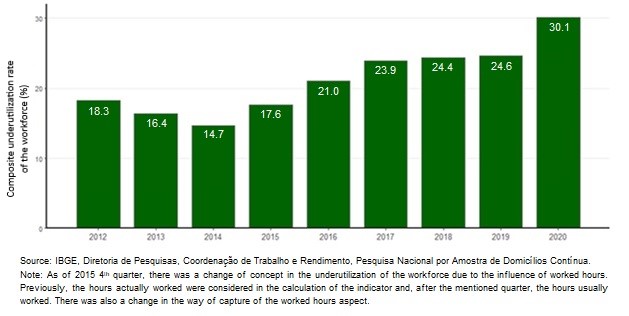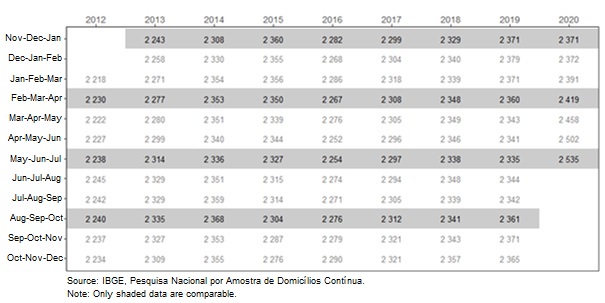Continuous PNAD: unemployment rate is 13.8%, underutilization rate is 30.1% in quarter ending in July 2020
September 30, 2020 09h00 AM | Last Updated: October 02, 2020 04h08 PM
The unemployment rate (13.8%) in the quarter from May to July 2020 was the highest one in the time series started in 2012, increasing 1.2 percentage points in relation to the quarter between February and April (12.6%) and 2.0 percentage points against the quarter from May to July 2019 (11.8%). The unemployed population (13.1 million persons) remained stable against the previous moving quarter (12.8 million) and rose 4.5% (more 561 thousand persons) against the same quarter in 2019 (12.6 million).
| Indicator / Period | May-Jun-Jul 2020 | Feb-Mar-Apr 2020 | May-Jun-Jul 2019 |
|---|---|---|---|
| Unemployment rate | 13.8% | 12.6% | 11.8% |
| Underutilization rate | 30.1% | 25.6% | 24.6% |
| Usual real earnings (R$) | 2,535 | 2,419 | 2,335 |
| Change of the usual real earnings in relation to: | 4.8% | 8.6% | |
The employed population (82.0 million, the smallest contingent in the time series) fell 8.1% (less 7.2 million persons) in relation to the previous quarter and 12.3% (less 11.6 million) against the same quarter of 2019. The employment-population ratio (47.1%) was also the lowest one in the time series, dropping 4.5 p.p. against the previous quarter and 7.6 p.p. against the same quarter of 2019.
The composite underutilization rate (30.1%) was a record in the time series, increasing 4.5 p.p. in relation to the previous moving quarter (25.6%) and 5.6 p.p. against the same quarter of 2019 (24.6%). The underutilized population (32.9 million persons) was also a record, rising 14.7% (more 4.2 million persons) against the previous quarter and 17.0% (more 4.8 million persons) against the same quarter of 2019.
The population in the workforce (95.2 million persons), the smallest one in the time series, fell 6.8% (less 6.9 million) against the previous quarter and 10.4% (less 11.0 million persons) in relation to the same quarter of 2019. The population out of the workforce (79.0 million persons) was a record in the time series, with rises of 11.3% (more 8.0 million persons) in relation to the previous quarter and of 21.8% (more 14.1 million persons) against the same quarter of 2019.
The discouraged population (5.8 million) was a record, with rises of 15.3% (more 771 thousand persons) compared with the previous quarter and of 20.0% (more 966 thousand persons) in relation to the same quarter in 2019. The percentage of discouraged in relation to the population in the workforce or discouraged (5.7%) was also a record, increasing 1.0 p.p. over the previous quarter and 1.4 p.p. against the same quarter of 2019.
Estimated at 29.4 million, the number of employed persons with a formal contract in the private sector (excluding domestic workers) was the smallest one in the time series, dropping 8.8% (less 2.8 million persons) against the previous quarter and 11.3% (less 3.8 million persons) over the same quarter of 2019. The number of employed persons without a formal contract in the private sector (8.7 million persons) fell 14.2% (less 1.4 million persons) in relation to the previous moving quarter and 25.4% (less 3.0 million) over the same quarter of 2019. The number of self-employed workers (21.4 million persons) dropped (-8.4% or less 2.0 million) against the previous moving quarter and also against the same period of 2019 (-11.6% or less 2.8 million persons).
The number of domestic workers (4.6 million persons) was the smallest one in the time series, dropping 16.8% (less 931 thousand persons) against the previous quarter and 26.9% (less 1.7 million persons) over the same period of 2019.
The informality rate hit 37.4% of the employed population (or 30.7 million informal workers). The rate had been 38.8% in the previous quarter and 41.3% in the same quarter of 2019.
The average usual real earnings (R$2,535) in the quarter ended in July increased 4.8% against the previous quarter and 8.6% in relation to the same quarter of 2019. The usual real wage bill (R$203.0 billion) fell 3.8% (less R$8.0 billion) over the previous quarter and 4.7% (less R$10 billion) against the same quarter of 2019.
Unemployment rate - Brazil - 2012-2020 (%)

Although the moving quarter between May and July 2020 registered the smallest contingent of employed population (82.0 million persons) in the entire time series of the survey, the percentage of drop of this population decelerated in relation to the retraction occurred in the quarter ended in June 2020.
The population out of the workforce (79.0 million) also hit its highest value in the time series with the resulting growth of 43.3% of the potential workforce. Despite the record contingents of these two populations, both of them expanded less in the quarter ended in July 2020. However, the population in the potential workforce (14 million) remained bigger than the unemployed population (13.1 million).
Compared with the previous moving quarter, the employed population decreased in eight out of the ten activity groups surveyed by the Continuous PNAD: Industry (8.0%, or less 916 thousand persons), Construction (9.5%, or less 559 thousand persons), Trade, repair of motor vehicles and motorcycles (9.7%, or less 1.6 million persons), Transportation, storage and mailing (11.9%, or less 562 thousand persons), Housing and food (23.2%, or less 1.1 million persons), Information, communication and financial, real estate, professional and administrative activities (3.7%, or less 381 thousand persons), Other services (16.9%, or less 803 thousand persons) and Domestic services (16.9%, or less 941 thousand persons). The groups of Agriculture, livestock, forestry, fishing and aquaculture and Public administration, defense, social security, education, human health and social services remained stable.
In relation to the same quarter of 2019, nine out of the ten groups reduced their employments: Agriculture, livestock, forestry, fishing and aquaculture (6.9%, or less 599 thousand persons), Industry (12.7%, or less 1.5 million persons), Construction (19.7%, or less 1.3 million persons), Trade, repair of motor vehicles and motorcycles (14.0%, or less 2.4 million persons), Transportation, storage and mailing (13.8%, or less 665 thousand persons), Housing and food (30.0%, or less 1.6 million persons), Information, communication and financial, real estate, professional and administrative activities (5.0%, or less 530 thousand persons), Other services (-22.5%, or less 1.1 million persons) and Domestic services (-26.9%, or less 1.7 million persons). Only the group of Public administration, defense, social security, education, human health and social services remained stable.
The potential workforce (14.0 million persons) hit its biggest contingent in the time series, growing 43.3% (more 4.2 million persons) over the previous moving quarter and 70.6% (more 5.8 million persons) against the same quarter of 2019.
The number of time-related underemployed persons (5.8 million) retreated against the previous moving quarter (-5.4% or less 330 thousand persons) and also in relation to the same quarter of 2019 (-21.3% or less 1.6 million persons).
The number of employers (3.9 million persons) dropped compared with the previous quarter (-6.3% or less 263 thousand persons) and also against the same quarter of 2019 (-9.1% or less 393 thousand persons).
The categories of those employed in the public sector (12.1 million persons), which includes statutory and military workers, remained stable against the previous quarter and increased 3.5% (more 405 thousand persons) in relation to the same quarter of 2019.
Composite underutilization rate – quarters from May to July – 2012-2020 - Brazil (%)

Compared with the previous moving quarter, the average usual real earnings increased in two activity groups: Industry (6.2% or more R$151) and Public administration, defense, social security, education, human health and social services (4.3% or more R$148). The other groups did not record any significant changes.
In relation to the same quarter of 2019, earnings grew in five groups: Industry (11.4% or more R$266), Trade, repair of motor vehicles and motorcycles (5.9% or more R$110), Housing and food (7.3% or more R$107), Public administration, defense, social security, education, human health and social services (4.7% or more R$165) and Other services (10.5% or more R$177). The other groups did not record any significant changes.
Average monthly usual real earnings from all jobs - Brazil - 2012/2020 (R$)


